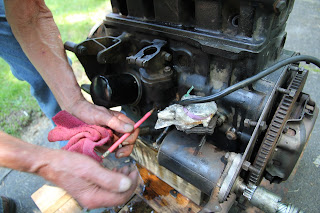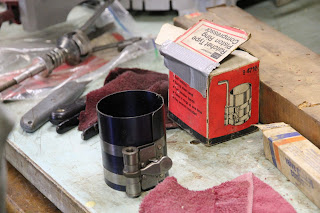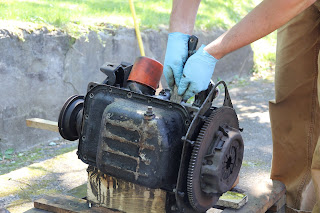Maybe "fiasco" is a bit dramatic, but the oil filter replacement ended up taking an hour, which is about 55 minutes longer than what it should have been.
To start, the oil filter was removed using an oil filter strap wrench...straightforward - no issues here.
When we went to put on the new oil filter, we noticed that it did not have a screw mount to attach to the engine. (See below, parts don't fit.)
Then we thought, "Well, maybe we needed to remove the screw from the old filter." So Fred tried freeing the screw using the 2-nut removal technique.
No luck here, so maybe some better access to the oil filter is needed. To do this, Fred sawed off the oil filter with a circular saw.
Still no luck removing the screw, so a little heat action was applied to see if this would help loosen the screw.
Being an oil filter, there was some oil leftover and this caught fire. (we put out the fire in the nearby water bucket)
What finally did the trick was grinding the screw out from the inside of the oil filter and then using a hammer to tap it out.
 |
| Finally removed |
While Chris and Fred were examining how to attach the newly freed screw and whether or not the threads survived the extraction process, I decided to review the parts I had bought for this trip to New York - some manifold clamps, gaskets, a fan belt... Then I took a closer look at the fan belt to read the packaging information and then I hear "clink clink clink" (the sound of metal falling onto the floor).
Hmm...what's this that fell out of the fan belt? (I asked myself) It turns out that I had ordered an oil filter adapter screw but that it had gotten stuck during shipping inside the fan belt packaging! We had the part all along!
 |
| The oil filter (left) and critical part to oil filter installation (right) |
With this new screw in hand, the oil filter installation took less than 1 minute to screw on...but with the time spent trying to salvage the old screw mount, we spent about an hour trying to install the oil filter. This was not one of our finer moments of the weekend, but I do need to applaud our determination to make things work and thank Fred for his patience and hard work.


















































